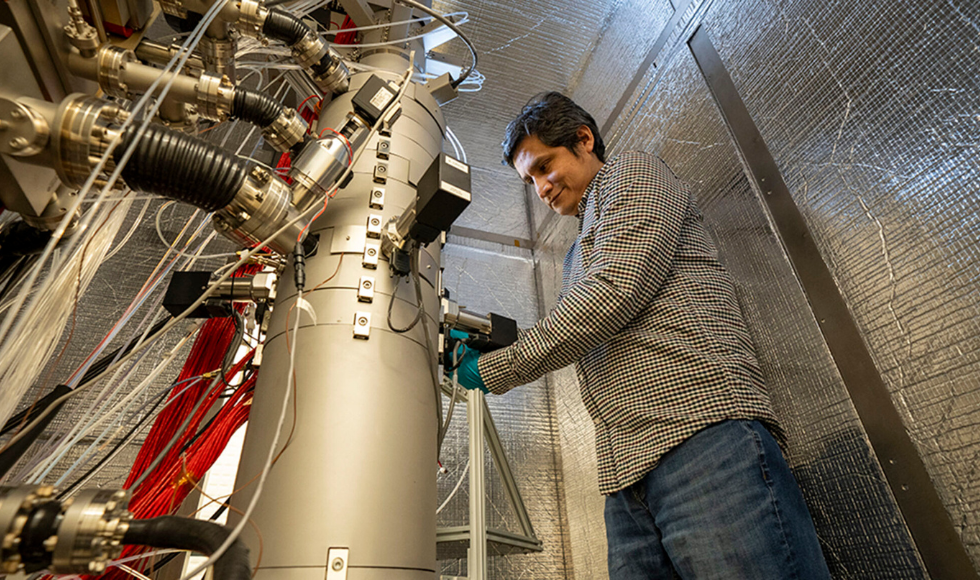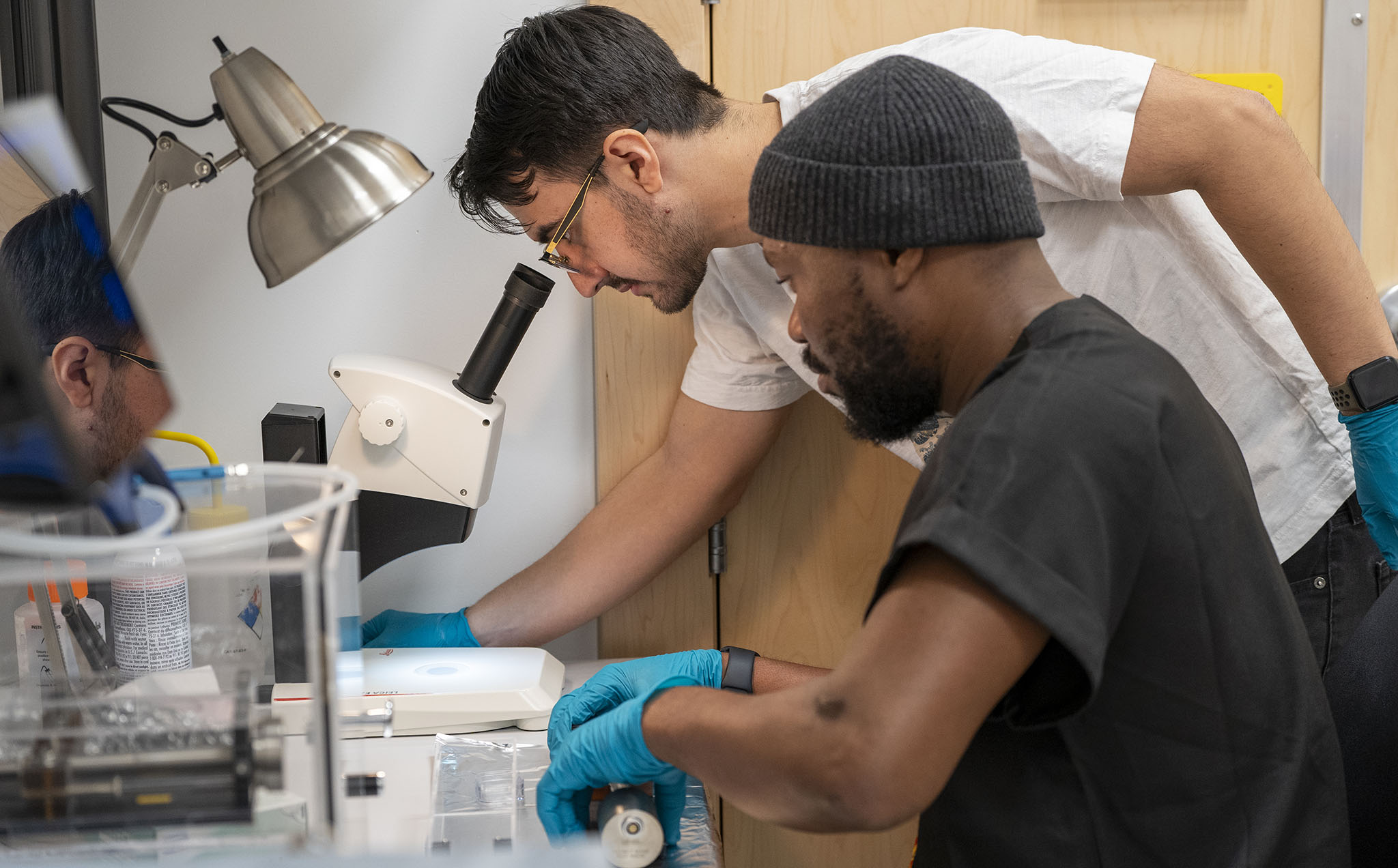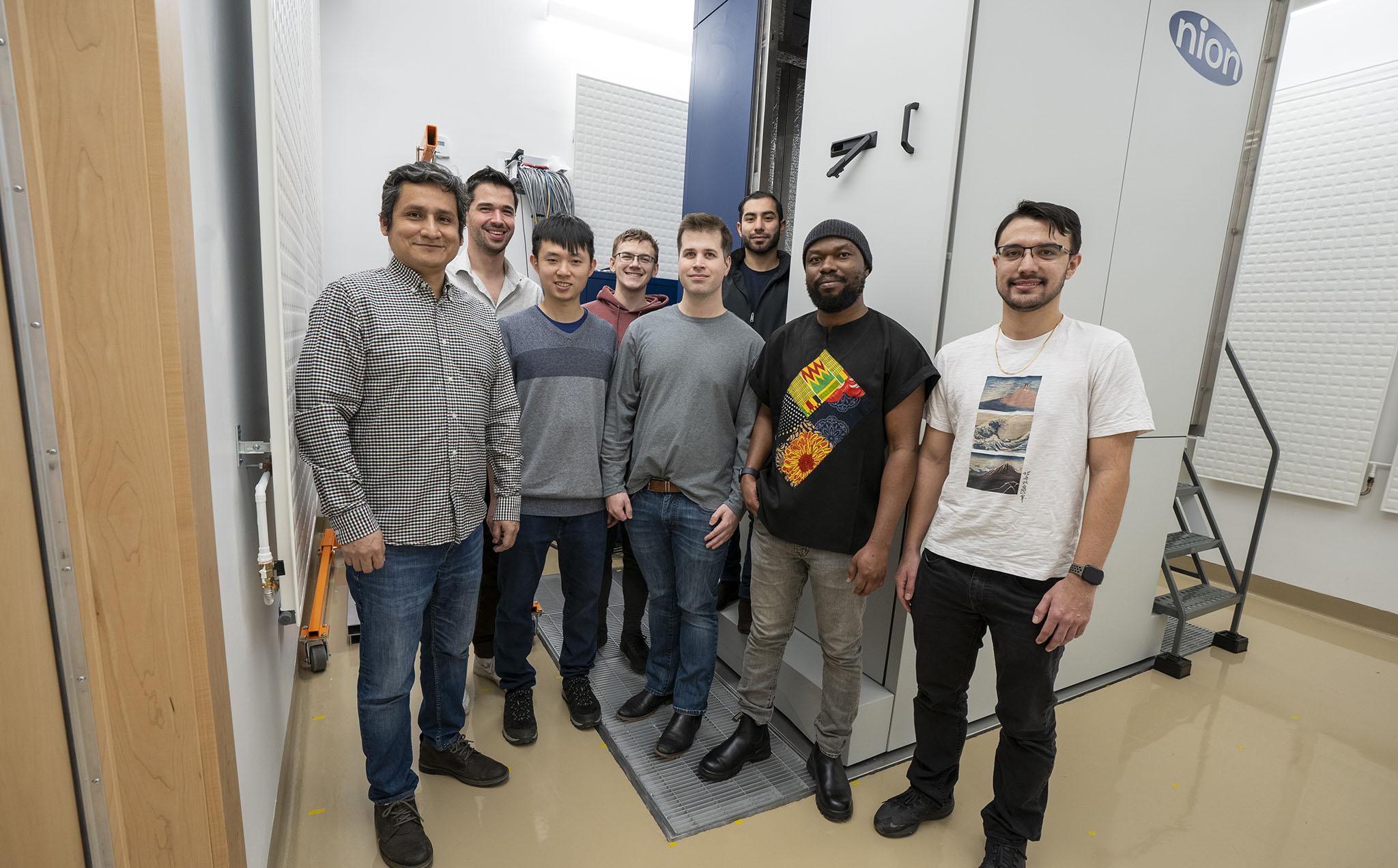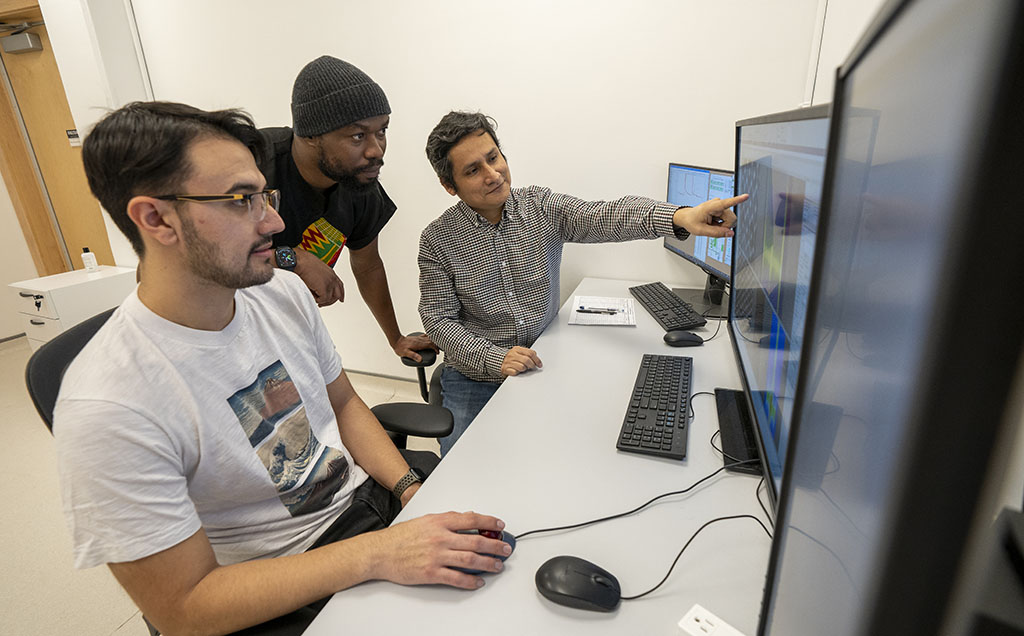Good vibrations: CCEM creates the right environment for advanced materials research

Maureen Joel Lagos working on the Nion HERMES 100 electron microscope. Lagos designed and oversaw the construction of a room that safeguards against any interference, including temperature fluctuations, floor vibrations and stray magnetic fields.
BY Keiko Kataoka
March 20, 2024
At a towering 10-foot height, the Nion HERMES 100 commands attention as one of the world’s most powerful electron microscopes, enabling researchers to scrutinize atomic particles with unparalleled precision.
At the Canadian Centre for Electron Microscopy (CCEM) at McMaster, home to Canada’s only Nion HERMES 100 electron microscope, researchers are studying atomic vibrations to better understand the relationship between the atomic structure and properties of advanced materials.
Maureen Joel Lagos, Canada Research Chair in Imaging and Spectroscopy of Advanced Nanomaterials and an associate professor of Materials Science and Engineering, leads a team using the electron microscope to advance materials research for application in quantum computing and semiconductor industries.
They’re focused on the electronic properties of semiconductors and superconductors, the optical response of photonic materials, and thermal behaviour of nanodevices.
“Our applied research helps with laying the scientific foundation to go beyond gradual improvements and further advance technologies that capitalize on properties of advanced materials,” explains Lagos.
A quiet place
Almost as impressive as the Nion HERMES 100 is the ultra-quiet room built for it.
Material analysis at the atomic level requires a highly controlled environment, immune to ambient disturbances.
“Even a sneeze from a researcher can compromise atom-level measurements.” says Lagos.
To minimize external disturbances and attain optimal results from the Nion HERMES 100, Lagos designed and oversaw the construction of a room that safeguards against any interference, including temperature fluctuations, floor vibrations and stray magnetic fields.
Unparalleled analysis
Housed in the basement of the AN Bourns Building, the electron microscope is available for faculty, student and visiting researchers to perform material characterization.
Engineering PhD students Babafemi Agboola and Joaquin Eduardo Reyes Gonzalez are enjoying having access to the Nion HERMES 100.

“I’m seeking to understand how small structural features, like defects, affect the atomic vibrations in solids,” explains Reyes Gonzalez, who studies phonons in semiconductor and superconductor materials.
“The electron beam allows us to go to the nanometric and atomic scale, and we can extract rich information to that level for detailed material characterization.”
One practical use for this information, he says, is understanding how properties of materials change at the nano- and micro scales to tackle the efficiency challenges in the electronics and semiconductor industries where devices are getting increasingly smaller.
“The Nion HERMES 100 is the best microscope in the world for this work.”
Agboola, who did his master’s in Nigeria, is focusing his research on quantum materials. He’s exploring fundamental excitations of materials like excitons with the aim of uncovering and understanding the optical and electronic properties of these materials.
This knowledge will be useful in the photonic and quantum computing industries in Canada.
“My passion is to pursue a career where I can help address Nigeria’s energy supply constraints by harnessing sunlight,” says Agboola.
Building interdisciplinary connections
Adjacent to the Nion HERMES 100’s room void of sound and movement is a bustling space for students and faculty to analyze and discuss visual outputs by the microscope.
“I insisted on this complementary space when designing the ultra-quiet room,” says Lagos. “It’s intended to inspire collaboration, spark scientific discussions, support student training on the equipment and shared analysis of work.”
Building meaningful, sustained connections across materials science and microscopy researchers is of deep significance for Lagos. He is routinely facilitating collaborations with other McMaster researchers to enhance the development of advanced materials.

McMaster research groups have joined efforts with Lagos’ group to tackle challenging projects at the frontier of engineering and science research.
Professor Andy Knights and Assistant Professor Ryan Lewis from Engineering Physics are studying electronic states of defects and mapping locally bandgaps in semiconductor nanostructures.
Drew Higgins, Assistant Professor in Chemical Engineering, is identifying the chemical composition of single atoms in catalytic systems. Nabil Bassim, Professor of Materials Science and Engineering and Scientific Director, Canadian Centre for Electron Microscopy, is analyzing plasmonic properties of layered nanosystems.
Pat Clancy, Assistant Professor and Graeme Luke, Professor from Physics and Astronomy are uncovering exotic properties of quantum materials, while Jose Moran-Mirabal, professor of chemistry and chemical biology, is unveiling vibrational behaviour of ligands attached to nanoparticles.
“These exciting projects and challenges were presented to us by some of the sharpest minds at McMaster,” says Lagos.
“Together, we are pushing the levels of material characterization to a new height and enhancing the development of materials. The Nion HERMES 100 is helping in all these research endeavours.”
Mentorship in microscopy
For Lagos, students come first, which means cultivating meaningful opportunities to work on innovative research projects in a diverse and inclusive research environment.
As a PhD advisor to Agboola and Reyes Gonzalez, Lagos offers critical mentorship to both students, involving them in his material research, ensuring their work is of the highest quality and giving them visibility in the field amongst professionals.
“Dr. Lagos motivates you to become the best scientist you can be, promotes us and gives us opportunities outside of the university to connect with great minds in the field,” says Agboola.
“It’s unique to have a supervisor sitting next to you offering guidance when performing complex experiments.”

Beyond his research enterprise, Lagos is also a proud contributor to the Latin American Network at McMaster University (LANMU). Established in 2021, LANMU is comprised of students, staff and faculty and acts as a hub for disciplinary, interdisciplinary and multidisciplinary research and teaching related to or performed by researchers from Latin America and its diasporas.
This initiative aligns with the McMaster Access Strategy, which serves to address a historical underrepresentation of Indigenous, Black and Latin-American students at the undergraduate level.
Lagos’ enthusiasm for student mentoring in LANMU helped influence Reyes Gonzalez’s participation as a mentor.
Spotlighting living electron microscopy legends
A passion for knowledge-sharing and a commitment to inspire the next generation of materials scientists and engineers led Lagos to co-lead the development of the International Microscopy Lecture Series with Natalie Reznikov from McGill University.
The series is a collaborative initiative involving four International Microscopy Societies and is supported by the International Federation of Societies for Microscopy.
The lecture series offers a platform for living legends in the field of microscopy to present their research and engage in conversation with one of their peers to discuss their scientific trajectory. To date, 12 lectures have been hosted and are available online, and includes the likes of microscopy pioneers and Nobel Laureates Joachim Frank and Dan Shechtman, and Kavli Prize-winning Sumio Iijima.
“Capturing the insights of some of the pioneers and leading voices in the field of electron microscopy helps to highlight their impact in the field, share their experiences and motivate young microscopists.” Says Lagos.
“It’s a passion project for me that I feel has significant reverberating benefits for anyone interested in this area of research and has the potential to make a positive impact on future generations.”


